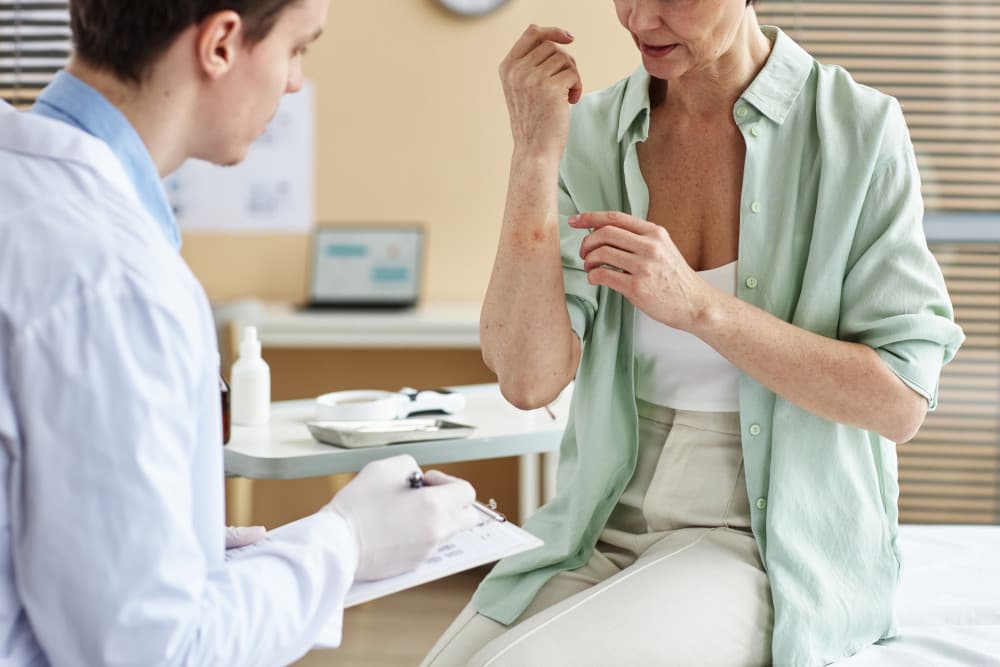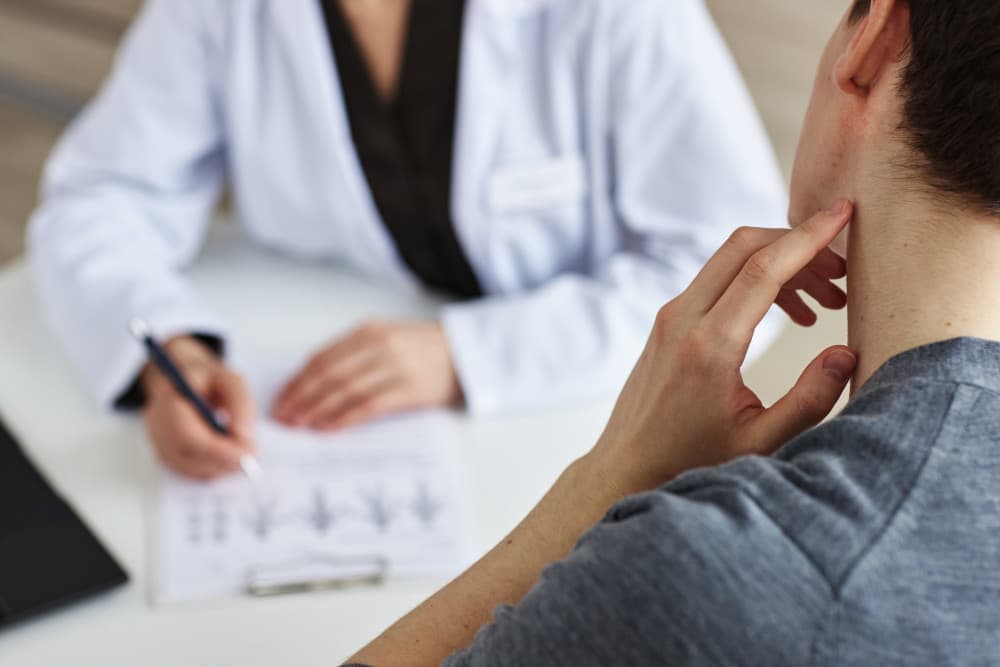Think You Have Psoriasis? Take Charge of Your Health with These Essential Next Steps

6 Minutes

Team Curative

Aug 10, 2024
What is psoriasis?
Psoriasis is a common yet complex skin condition affecting millions of individuals nationwide. As we delve into National Psoriasis Action Month this August, it's essential to shed light on this often misunderstood disease. Psoriasis is a chronic skin disease that causes a rash of itchy, scaly patches. There is no known cure. These patches appear most commonly on the knees, elbows, trunk, and scalp. According to the National Psoriasis Foundation, psoriasis affects more than 7.5 million people, or over 3 percent of the US adult population.
People with family members who have Psoriasis are more likely to have it, too. Infections, cuts, burns, and certain medications can worsen it. Understanding its triggers and seeking preventive care can help people diagnose, monitor, and manage this chronic condition effectively.
The impact of psoriasis Psoriasis can be painful. Affected people often experience pain and itchiness that interferes with sleep and makes concentrating difficult. Having psoriasis increases the risk of developing other conditions, including:
Psoriatic arthritis, a chronic form of arthritis that affects the joints and laces where tendons and ligaments attach to bones
Cardiovascular events such as heart attacks and strokes
Mental health challenges including low self-esteem, anxiety, and depression
Certain cancers, Crohn’s disease, diabetes, metabolic syndrome, obesity, osteoporosis, uveitis (inflammation in the eye), liver disease, and kidney disease
Keep reading to learn how to spot psoriasis and determine steps you may want to consider if you think you may be affected.

Recognizing psoriasis symptoms
According to the American Academy of Dermatology Association, psoriasis can be identified by dry, thick, raised patches on the skin. These patches are often covered with an itchy, silvery-white coating called scale. While these patches are the most common signs of psoriasis, the condition can cause various symptoms. These vary depending on the type and amount of psoriasis and the places it appears on your body.
There are several different types of psoriasis:
Plaque psoriasis (This type affects 80-90% of people with psoriasis.)
Guttate psoriasis (In this type of psoriasis, scaly, itchy bumps appear suddenly on many body parts. This form is often temporary.)
Inverse psoriasis (This type occurs where skin touches skin, as in the underarms, and causes skin soreness.)
Pustular psoriasis (In this type, painful pustular sores appear on the hands and feet.)
Generalized psoriasis (This life-threatening type of psoriasis begins with a flare-up of pustular sores over the entire body and causes illness.)
Erythrodermic psoriasis (This life-threatening condition causes illness and extreme itchiness and pain).
Nail psoriasis
Psoriatic arthritis (This occurs when psoriasis affects the joints and results in pain and stiffness in the joints.)
Understanding the specifics can aid in seeking appropriate treatment.
Seeking treatment for psoriasis
If you or a loved one are experiencing these symptoms, you should schedule an appointment with a medical provider specializing in dermatology to seek a diagnosis. At this appointment, your healthcare provider will ask questions about your health and examine your skin, scalp, and nails. They might biopsy your skin by taking a small sample to be examined under a microscope. A biopsy helps determine the type of psoriasis you are experiencing and rules out other disorders.
A variety of psoriasis treatments exist. These treatments aim to stop skin cells from proliferating and to remove scales. They include:
Topical therapy, including creams and ointments
Light therapy
Oral medications
Injected medications
Providers prescribe different treatments depending on the severity of symptoms, the condition’s responsiveness to previous therapy, and patients’ self-care measures. Providers start with the mildest treatments: topical creams and light therapy. Often, patients must try a variety of treatments before finding an approach that works. Psoriasis symptoms typically return even after successful treatment.
What lifestyle changes can improve psoriasis symptoms?
The American Academy of Dermatology Association (AADA) recommends lifestyle changes to improve psoriasis symptoms and limit the risk of developing related diseases. The AADA advises people living with psoriasis to do the following:
Quit smoking.
Limit alcohol.
Maintain a healthy weight.
Eat a healthy, balanced diet.
Exercise.
Get screened for related diseases.
Find a dermatologist and keep your appointments.

What is the role of preventive care in psoriasis treatment?
Access to ongoing preventive healthcare is essential for people with chronic diseases like psoriasis. Regular provider visits and consistent follow-through ensure your condition is monitored and treated.
Preventive care empowers you to take control of certain aspects of your medical care. With your provider’s help, you can better understand your psoriasis symptoms, triggers, and treatment. You can discuss lifestyle changes that may relieve symptoms and understand the risk factors that may worsen them. When you have an ongoing relationship with your provider, they can detect changes in your condition and provide early diagnosis and treatment.
Preventive care helps you better understand your overall health and can address minor medical issues before they become full-blown medical crises, which is particularly important for people living with chronic disease. In the realm of psoriasis management, knowledge is empowerment. By understanding the condition, exploring available treatments, embracing lifestyle changes, and prioritizing preventive care, people living with psoriasis can confidently navigate their journey, supported by comprehensive resources and personalized healthcare solutions.
Curative: health insurance that values preventive care and psoriasis support
Curative is a new kind of employer-sponsored health insurance based on affordability, engagement, and simplicity. Curative’s plan helps you overcome barriers to care, including:
Lack of access
Confusion about healthcare coverage
Fear of medical debt
The Curative health insurance model prioritizes preventive care. Members are never alone in figuring out where to find preventive care services, including health screenings and psoriasis treatment. With Curative, you can focus on healthcare, not health costs.
To improve access to patients suffering from Psoriasis, many dermatologists and mental health providers offer virtual visit options (often referred to as telehealth or teledermatology). Curative offers access to an extensive telehealth network that can provide ongoing support with increased patient scheduling and geographic flexibility
Curative is:
Easy to pay for: Curative feature $0 in copays and $0 in deductibles.
Easy to access: Curative works with your doctors to assist you with appointments, follow-ups, and more.
Easy to navigate: Members receive guidance about benefits, and 24/7 telehealth can help you get the care where and when you need it.
Focused on improving member health: Preventive health leads to a healthier and more productive you.
Insurance you actually want to use: Curative health plans have no hidden costs, so you can confidently use your benefits.
Once curative members complete their Baseline Visit (within the first 120 days of coverage) they qualify for $0 deductibles, $0 copays, and $0 out-of-pocket costs. During the Baseline Visit, curative members meet their preventive care provider, discuss their overall health and concerns, and develop treatment plans when necessary. Curative plans also include a Care Navigator whose expert guidance helps support you throughout your healthcare journey. Your Care Navigator knows your plan inside and out and can help you find the providers and care you need to live your healthiest life.
Curative wants people to love using their health benefits. The Curative health plan delivers better health through affordability, engagement, and simplicity without copays and deductibles—really! Learn more about securing effective preventive care through Curative today.
To see all disclaimers, please view them here.
Resources
American Academy of Dermatology Association (2024). Healthy Diet and Other Lifestyle Changes That Can Improve Psoriasis.
https://www.aad.org/public/diseases/psoriasis/insider/diet
American Academy of Dermatology Association (2024). Psoriasis: Signs and Symptoms.
https://www.aad.org/public/diseases/psoriasis/what/symptoms
Mayo Clinic. (May 17, 2024). Psoriasis Diagnosis & Treatment.
https://www.mayoclinic.org/diseases-conditions/psoriasis/diagnosis-treatment/drc-20355845
Mayo Clinic. (May 17, 2024). Psoriasis Symptoms & Causes.
https://www.mayoclinic.org/diseases-conditions/psoriasis/symptoms-causes/syc-20355840
National Psoriasis Foundation. (July 2024). Psoriasis Action Month.
Sign up for our Newsletter
Índice de Contenidos
What is psoriasis?
Recognizing psoriasis symptoms
Seeking treatment for psoriasis
What lifestyle changes can improve psoriasis symptoms?
What is the role of preventive care in psoriasis treatment?
Curative: health insurance that values preventive care and psoriasis support
Curative is:
Resources








